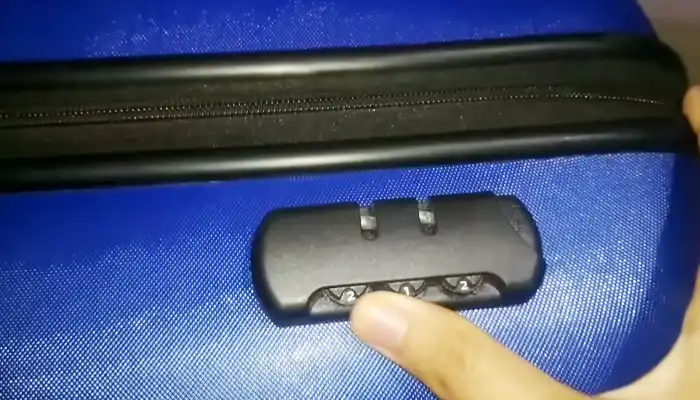
You’re about to head out on your long-awaited vacation when you go to pack your suitcase and realize that the luggage lock is jammed. Or, Have you ever arrived at your destination only to find that your luggage lock is jammed? If so, you’re not the only one. Luggage locks are prone to jamming, but fortunately, you can fix this issue easily.
If you’ve ever had your luggage lock jam on you, you know what a frustrating experience it can be. Whether you’re trying to open your bag to get to your clothes or you’re trying to close it up tight to keep everything secure, a jammed lock can make the process take forever.
We will cover how to fix a jammed luggage lock in this article. Also, we will answer some relevant questions, such as what causes luggage locks to jam in the first place and how you can prevent it from happening again.
How to Fix a Jammed Luggage Lock: Effective Steps
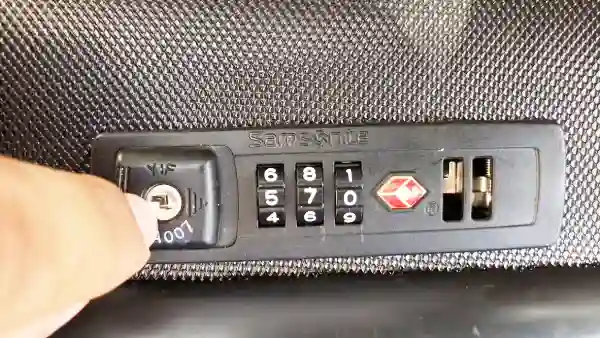
Here, we will outline some effective steps you can take to fix your jammed luggage lock. So, read on to learn more.
1. Try Wiggling Back and Forth:
If your luggage lock is jammed, the first thing you should do is try to wiggle it back and forth. This may seem like an obvious solution, but sometimes the simplest solutions are the best.
In some cases, it will only take a bit of movement to get the lock back in working order. Don’t get your hopes up, though. If the lock is truly jammed, this method may not work.
2. Remove Foreign Particles from the Luggage Lock:
Start by taking a close look at the lock. In many cases, a visual inspection will reveal what’s causing the problem. If there is any filth or grime that is preventing the lock from opening, try and remove it with a small brush or toothpick.
You can also try using a can of compressed air. This will help to loosen any build-up that may be causing the lock to jam. Simply point the nozzle of the compressed air can at the keyhole and give it a few good blasts.
3. Determine Shackle Position:
Now, observe if the shackle (the U-shaped metal piece) is stuck in the open position or the closed position. If the shackle is stuck in the open position, try gently pushing and pulling on it until it moves. Sometimes all it takes is a little wiggling to get things unstuck.
4. Use WD-40:
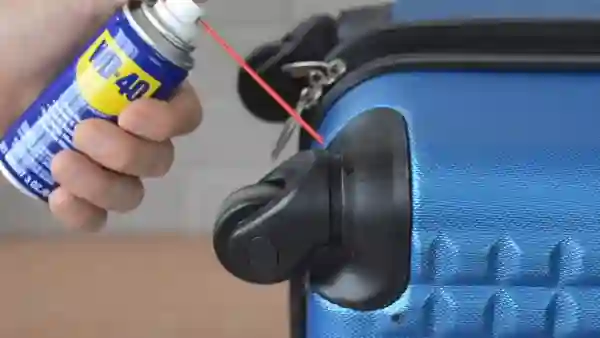
If gentle pushing and pulling don’t do the trick, try using WD-40 or another lubricant spray. Just be sure to use it sparingly, as too much lubricant can attract grime and grime and worsen the problem. Apply the lubricant directly to the shackle and work it back and forth until it moves freely.
5. Use Blunt Force to Tap Shackle:
If neither of those methods works, try using a small hammer or mallet to tap on the shackle until it pops open. Be careful not to hit too hard, or you could damage the mechanism inside the lock.
6. Test the Lock With a Key:
Once you’ve freed up the shackle, test the lock to see if it works properly before reattaching it to your luggage. To do this, insert the key and turn it clockwise as far as it will go. Then turn it counterclockwise until a click is heard. You should now be able to pop open the shackle. If not, repeat Steps 2 through 5 until it does.
7. Remove Keyhole Blockage:
If you can’t get the shackle unstuck, don’t worry, there’s still hope. To begin with, take a look at the keyhole to see if there’s anything blocking it. If so, use a toothpick or small brush to clear away any particles.
Sometimes the keyhole can become misaligned, which will prevent the key from properly engaging with the mechanism. Use a small screwdriver or paperclip to try and realign the keyhole.
Once the keyhole is clear, try inserting your key again and turning it clockwise so that it turns freely before turning it counterclockwise to check for a click. The shackle should now pop open just like before.
8. Use a Wire Cutter/Plier to Remove Shackle:
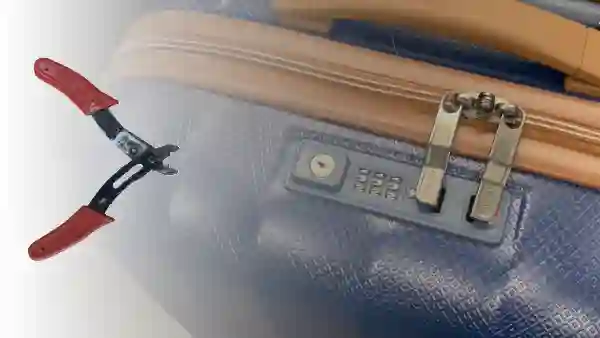
If none of those methods work, your last resort is to use pliers or wire cutters to remove the shackle entirely (be sure you won’t need that lock again before taking this step). Insert your key into the keyhole and turn clockwise as far as possible before turning counterclockwise until you hear a click.
This will release some of the tension on the shackle so that you can remove it more easily with your tools. Next, grip one side of the shackle with your pliers or wire cutters and twist until it snaps off. Then repeat on the other side.
Warning: This method should only be used as a last resort since damaged locks cannot be repaired and must be replaced completely.
9. Open and Inspect:
If the shackle isn’t the problem, or if you can’t fix it with a visual inspection, it’s time to take the lock apart. Begin by removing the screws that hold the back plate in place (there are usually two or three).
Once the back plate is off, you can see the locking mechanism inside. You may also use a small hammer or pliers to try and break open the lock. Be careful not to damage your luggage in the process.
10. Spring Issue:
If the mechanism looks clean and unobstructed but still isn’t working properly, there may be an issue with the springs inside the lock. At this point, it’s best to take the lock to a professional for further diagnosis and repair.
11. Use Heat:
If your luggage lock jams because of cold weather, you can try using heat to fix it. Use a hair dryer or other type of heat source to apply heat to the keyhole for a few minutes. Once the keyhole is warmed up, try operating the lock again.
12. Replace the Batteries:
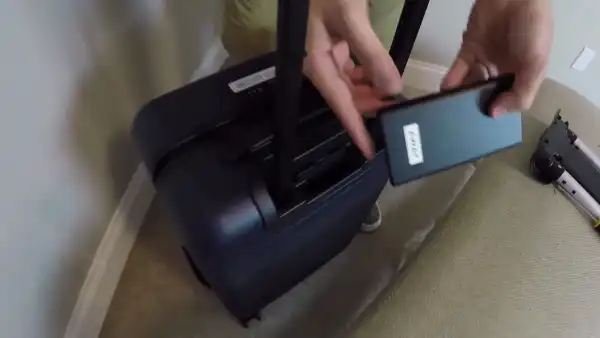
If your electronic luggage lock is jammed, one possible cause is dead batteries. Try replacing the batteries in your lock and see if that fixes the problem. If your luggage lock uses AA batteries, you may want to carry extras with you when you travel in case this happens again.
13. Change or Ask for Help from Manufacturers:
If none of these steps work, then, unfortunately, you will likely need to replace your luggage lock. Also, you can contact customer service for assistance. Many companies that make luggage locks offer customer service and will be able to help you troubleshoot your problem over the phone or through email
What Type of Chemicals Should be Used to Clean a Jammed Luggage Lock?
When a TSA-approved luggage lock becomes jammed, it can be frustrating and time-consuming to get it open. While there are a number of ways to open a jammed lock, the most effective method depends on the type of lock and the cause of the jam.
In most cases, a simple lubricant such as WD-40 or olive oil will do the trick. Simply spray or drizzle the lubricant into the keyhole and let it sit for a moment before attempting to open it. If that doesn’t work, you may need to use a stronger solvent, such as acetone or nail polish remover.
Be sure to test the solvent on an inconspicuous area of the bag first to ensure that it won’t damage the fabric. Once you’ve applied the solvent, wait a few minutes before trying to open the lock again. If all else fails, you can always take the lock to a locksmith or baggage service desk for professional assistance.
Is It Safe to Force a Luggage Lock to Open?
Most people have experienced the frustration of a jammed luggage lock, especially when they’re in a hurry to catch a flight. Even though it may seem an easy solution to force the lock open, doing so can damage the mechanism and make it more difficult to close the suitcase properly in the future.
Also, forcing the lock open could cause the release button to pop off, rendering the lock useless. If you find yourself in this situation, your best bet is to contact the manufacturer or a locksmith who can help you open the lock without causing any damage. In general, it’s best to avoid forcing a luggage lock open, as it can lead to costly repairs or replacement.
Can a Locksmith Open a Jammed TSA Luggage Lock?
A locksmith can usually unlock a jammed TSA luggage lock. In any case, there are a few things to keep in mind. To begin with, the locksmith will need proof that you own the luggage. Then, the locksmith will likely need to drill out the lock, which may damage your luggage.
Also, the process can be costly, so it is important to weigh your options carefully before deciding to hire a locksmith. If you decide to go ahead with the process, be sure to find a reputable locksmith who has experience opening jammed TSA locks.
Is It Possible To Open a Jammed Padlock?
It is not uncommon for a padlock to become jammed. Over time, the internal components can become corroded or gummed up with filth and grime, making it difficult to open the lock. In some cases, the key may even become stuck inside the lock itself.
While it may be tempting to force open the lock, this will damage the mechanism, making the lock even more difficult to open in the future. Luckily, there are a few tricks that can be used to open a jammed padlock.
To begin with, try spraying the lock with WD-40 or another lubricant. This can help to loosen the internal components and make it easier to turn the key. If this does not work, try using a pick or other tool to gently pry open the lock.

Why Should You Fix a Jammed Luggage Lock Instead of Buying a New One?
When your suitcase lock gets jammed, it may seem like the easiest solution is to simply buy a new one. No matter what, there are a few reasons why you may want to consider fixing the jammed lock instead. First of all, replacing a luggage lock is not always as simple as it sounds.
If the lock is attached to the zipper, then you will need to sew on a new one, which can be time-consuming and difficult. Even if the lock is not attached to the zipper, it can be hard to find an exact match for your luggage.
Also, fixing a jammed luggage lock is usually much less expensive than buying a new one. All you will need is some lubricant and a few basic tools, and you should be able to fix the lock in just a few minutes. Then, by fixing the lock yourself, you will avoid the hassle of having to keep track of a new key or combination.
Conclusion
Hopefully, after reading this article, There will be no need to call a locksmith or buy a new lock. With a little patience and some household supplies, you can fix that jammed lock. Your vacation plans don’t have to be ruined by a jammed luggage lock anymore.
Next time you’re packing for a trip, make sure to keep these steps in mind so you can avoid any stressful situations at the airport. And who knows? maybe you’ll even be able to impress your travel companions with your handy skills. Bon voyage.
You Can Also Read:
